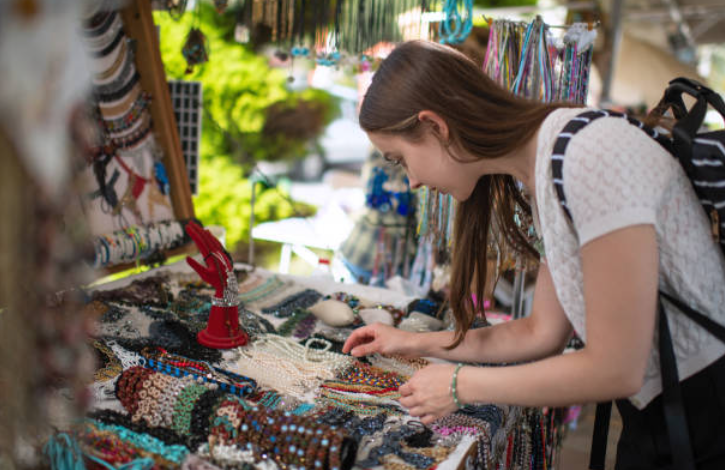Best Digital Tools for Running an Arts and Crafts Fair Booth

Running a booth at an arts and crafts fair is an exciting way to showcase creativity, connect with customers, and grow your business. But to stand out among dozens of other booths, you need more than just beautiful products — you need smart tools to manage sales, promote your work, and create a memorable experience. Digital platforms make this process smoother, helping artists focus on what they do best: creating.
Here are the best digital tools for running a successful arts and crafts fair booth.
1. Square: Hassle-Free Payment Processing
Cash-only booths can turn away potential buyers. Square provides portable card readers that connect to your phone or tablet, making it easy to accept debit and credit card payments.
Its dashboard tracks sales in real time, so you know which items are most popular. You can even set up inventory management, which helps ensure you don’t oversell limited-edition pieces. For artists on the go, Square makes every transaction quick and professional.
2. Canva: Create Eye-Catching Signage
Your booth’s look is just as important as your products. Canva offers easy-to-use templates for posters, banners, and price signs. With drag-and-drop tools, you can customize colors, fonts, and layouts to match your brand.
One creative tip: use Canva to design QR codes that link to your website or Instagram page, then include them on your signage. This gives customers a way to follow your work long after the fair.
3. Trello: Stay Organized Before the Event
Preparation is key to running a smooth booth. Trello helps you organize everything from supply lists to setup checklists. Its visual boards let you assign tasks and deadlines, ensuring nothing slips through the cracks.
A helpful tip is to create a “Fair Day Checklist” with cards for each stage: setup, booth operation, and takedown. Having it all mapped out keeps stress levels low and productivity high.
See also: Benefits of Hiring an Experienced Siding Contractor Sacramento
4. Instagram: Build Buzz Before and During the Fair
Social media is a powerful tool for driving traffic to your booth. Instagram lets you showcase your products, share behind-the-scenes preparation, and use hashtags to connect with local fairgoers.
On fair day, posting Stories or going Live can draw in people who are already nearby. Using geotags helps ensure your booth gets noticed by attendees scrolling their feeds. The platform doubles as both a marketing tool and a way to strengthen your artist community.
5. Mailchimp: Collect Emails for Future Marketing
A fair may last just a day or weekend, but its impact can extend far longer if you stay connected. Mailchimp makes it easy to collect customer emails and send newsletters about upcoming fairs, new products, or online shop launches.
Bring a tablet or printed sign-up sheet to your booth, then upload contacts directly into Mailchimp. By nurturing relationships beyond the fair, you’ll turn casual buyers into loyal fans.
6. Google Photos: Showcase Your Work Digitally
Not every potential customer can carry large items around the fair. Google Photos allows you to create albums that display your full range of work. With a quick scan of a QR code, customers can browse additional products digitally, even if they’re not on display.
This tool also helps build a professional portfolio you can share with galleries, shops, or future fair organizers. By extending your booth into the digital realm, you expand opportunities for sales and exposure.
💌 FAQ: Card Design for Arts and Crafts Fair Booths
One often-overlooked detail at fairs is the importance of cards. Whether they’re thank-you notes, product information cards, or business cards, they leave a lasting impression. Here are answers to common questions artists and makers often ask about card design for their booths.
Why should I invest in custom card design for my booth?
Cards serve as take-home reminders of your brand. They make it easier for customers to reconnect with you after the fair, boosting chances of repeat business.
What are the best tools for creating professional cards?
Popular options include Adobe Express, Moo, and Vistaprint. Adobe Express is great for beginners, while Moo specializes in premium finishes, and Vistaprint offers bulk affordability.
How can card design reflect my artistic brand?
Use consistent colors, fonts, and imagery that match your art style. Adding QR codes that link to your shop or social media ensures your cards are both beautiful and functional.
Which service is fastest for printing cards before a fair?
Adobe Express is particularly convenient — you can create free print cards directly after designing, making it an all-in-one solution when time is tight.
Are eco-friendly card options available?
Yes. Many printing services now offer recycled paper and sustainable ink options. Eco-friendly cards align with the values of many fairgoers and show a commitment to sustainability.
Running an arts and crafts fair booth is a blend of creativity, organization, and marketing. Tools like Square, Canva, and Instagram ensure your booth is not only functional but also memorable.
By adding professional card design to your toolkit, you can extend the impact of the fair beyond the event itself, keeping your art in the hands and minds of customers. With the right digital tools, your booth can shine brighter and bring in lasting connections.
